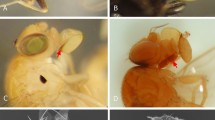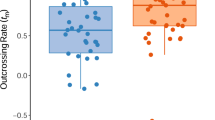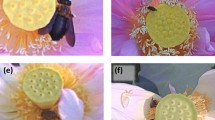Abstract
The relative attractiveness to pollinators (syrphid flies) of the radiate and non-radiate morphs of Senecio vulgaris was recorded in an artificial stand in which morphs occurred at equal frequency. Pollinators showed marked discrimination in favour of the radiate morph ; 72 per cent of 336 visits were to plants bearing radiate capitula. Analysis of pollinator flights between plants showed a bias for radiate to radiate transitions (R-R), followed by non-radiate to radiate (N-R), then radiate to non-radiate (R-N) transitions. Flights between non-radiate plants (N-N) were very infrequent. The greater frequency of N-R relative to R-N transitions resulted from an increase in preference for the radiate morph as pollinators moved from the first to the second plant during a flight sequence. A cause of this behaviour is suggested. Given certain assumptions, the observed pattern of intermorph transition flights would explain, in part, the greater female outcrossing by the radiate morph based on intermorph crossing, and, in turn, the higher female outcrossing rate of radiate relative to non-radiate disc florets recorded previously in some polymorphic populations.
Similar content being viewed by others
Article PDF
References
Burtt, B L. 1977. Aspects of diversification in the capitulum. Heywood, V. H., Harborne, J. B. and Turner, B. L. In The Biology and Chemistry of the Compositae Vol. 1, Academic Press, London, pp. 41–59.
Marshall, D F, and Abbott, R J. 1982. Polymorphism for outcrossing frequency at the ray floret locus in Senecio vulgaris L. I. Evidence. Heredity, 48, 227–235.
Marshall, D F, and Abbott, R J. 1984a. Polymorphism for outcrossing frequency at the ray floret locus in Senecio vulgaris L. II. Confirmation. Heredity, 52, 331–336.
Marshall, D F, and Abbott, R J. 1984b. Polymorphism for outcrossing frequency at the ray floret locus in Senecio vulgaris L. III. Causes. Heredity, 53, 145–149.
Ross, M D, and Abbott, R J. 1987. Fitness, sexual asymmetry, functional sex and selfing in Senecio vulgaris L. Evolutionary Trends in Plants, 1, 21–28.
Warren, J M. Crawford, T J, and Oxford, G S. 1987. Inhibition of self-pollen germination in Senecio vulgaris L. Heredity, (in press).
Author information
Authors and Affiliations
Rights and permissions
About this article
Cite this article
Abbott, R., Irwin, J. Pollinator movements and the polymorphism for outcrossing rate at the ray floret locus in Groundsel, Senecio vulgaris L.. Heredity 60, 295–298 (1988). https://doi.org/10.1038/hdy.1988.45
Received:
Issue date:
DOI: https://doi.org/10.1038/hdy.1988.45
This article is cited by
-
Rapid evolution of hybrid breakdown following recent divergence with gene flow in Senecio species on Mount Etna, Sicily
Heredity (2023)
-
Reproductive Biology of Asteraceae on Oceanic Islands
The Botanical Review (2023)
-
Recent hybrid origin and invasion of the British Isles by a self-incompatible species, Oxford ragwort (Senecio squalidus L., Asteraceae)
Biological Invasions (2009)
-
Reproductive isolation of a new hybrid species, Senecio eboracensis Abbott & Lowe (Asteraceae)
Heredity (2004)
-
Chloroplast DNA and isozyme evidence on the evolution ofSenecio vulgaris (Asteraceae)
Plant Systematics and Evolution (1997)



